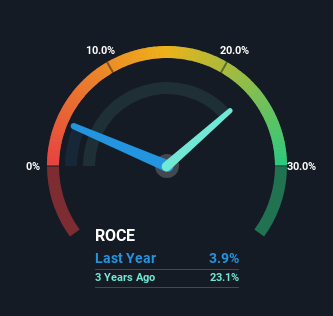
If we want to find a stock that could multiply over the long term, what are the underlying trends we should look for? Firstly, we'll want to see a proven return on capital employed (ROCE) that is increasing, and secondly, an expanding base of capital employed. Basically this means that a company has profitable initiatives that it can continue to reinvest in, which is a trait of a compounding machine. Having said that, from a first glance at BetterLife Holding (HKG:6909) we aren't jumping out of our chairs at how returns are trending, but let's have a deeper look.
What Is Return On Capital Employed (ROCE)?
Just to clarify if you're unsure, ROCE is a metric for evaluating how much pre-tax income (in percentage terms) a company earns on the capital invested in its business. The formula for this calculation on BetterLife Holding is:
Return on Capital Employed = Earnings Before Interest and Tax (EBIT) ÷ (Total Assets - Current Liabilities)
0.039 = CN¥135m ÷ (CN¥4.8b - CN¥1.3b) (Based on the trailing twelve months to June 2024).
Therefore, BetterLife Holding has an ROCE of 3.9%. In absolute terms, that's a low return and it also under-performs the Specialty Retail industry average of 8.9%.
Check out our latest analysis for BetterLife Holding

Historical performance is a great place to start when researching a stock so above you can see the gauge for BetterLife Holding's ROCE against it's prior returns. If you're interested in investigating BetterLife Holding's past further, check out this free graph covering BetterLife Holding's past earnings, revenue and cash flow.
What The Trend Of ROCE Can Tell Us
On the surface, the trend of ROCE at BetterLife Holding doesn't inspire confidence. Around five years ago the returns on capital were 21%, but since then they've fallen to 3.9%. Given the business is employing more capital while revenue has slipped, this is a bit concerning. This could mean that the business is losing its competitive advantage or market share, because while more money is being put into ventures, it's actually producing a lower return - "less bang for their buck" per se.
On a related note, BetterLife Holding has decreased its current liabilities to 28% of total assets. So we could link some of this to the decrease in ROCE. What's more, this can reduce some aspects of risk to the business because now the company's suppliers or short-term creditors are funding less of its operations. Some would claim this reduces the business' efficiency at generating ROCE since it is now funding more of the operations with its own money.
The Bottom Line
From the above analysis, we find it rather worrisome that returns on capital and sales for BetterLife Holding have fallen, meanwhile the business is employing more capital than it was five years ago. This could explain why the stock has sunk a total of 82% in the last three years. That being the case, unless the underlying trends revert to a more positive trajectory, we'd consider looking elsewhere.
BetterLife Holding does have some risks, we noticed 4 warning signs (and 1 which is potentially serious) we think you should know about.
For those who like to invest in solid companies, check out this free list of companies with solid balance sheets and high returns on equity.
Have feedback on this article? Concerned about the content? Get in touch with us directly. Alternatively, email editorial-team (at) simplywallst.com.
This article by Simply Wall St is general in nature. We provide commentary based on historical data and analyst forecasts only using an unbiased methodology and our articles are not intended to be financial advice. It does not constitute a recommendation to buy or sell any stock, and does not take account of your objectives, or your financial situation. We aim to bring you long-term focused analysis driven by fundamental data. Note that our analysis may not factor in the latest price-sensitive company announcements or qualitative material. Simply Wall St has no position in any stocks mentioned.